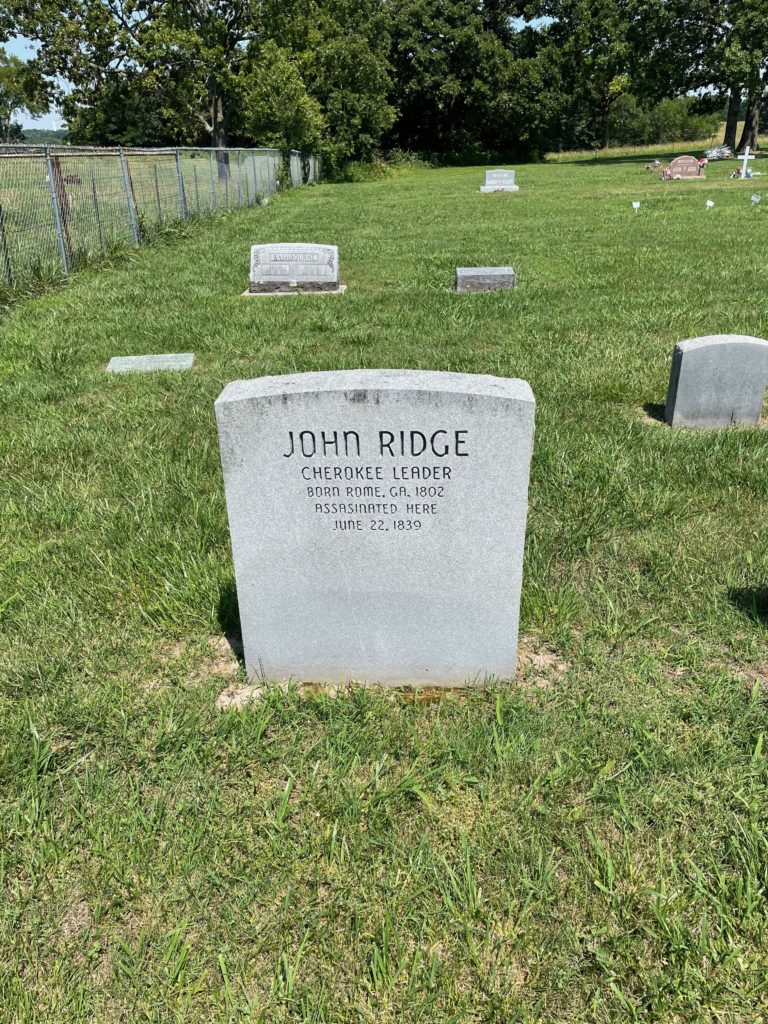Erik Visits an American Grave, Part 1,149
This is the grave of John Ridge.

Born sometime around 1802 in what is today Rome, Georgia, Yellow Bird (or Skah-tle-loh-skee in Cherokee) grew up in the Cherokee elite. Ever since the mid-18th century, Cherokee leaders had adopted southern Anglo ways as a strategy for survival against the ever growing demands for land from whites. So if they transitioned their own forms of slavery into chattel slavery, converted to Christianity, created a written language, started newspapers, and opened schools, maybe whites would leave them alone. Well, that didn’t happen, but it shaped the young Yellow Bird as he grew up in this.
Ridge’s father was the prominent Cherokee chief who would take the name Major Ridge in English, as his son would take the name John. The Moravians were among the Christian groups in Cherokee county and he went to their mission school. Then, in 1819, his father sent him to the Foreign Mission School in Connecticut, is where indigenous people (among others from the missionized around the world) went to get the high-class education that leadership required. So Ridge learned to read and write in English and the other rudiments of classical education. His cousin, Elias Boudinot, also attended the school. Ridge was a very good student and in fact was not only at the top of the class, but wrote a letter to James Monroe at the bequest of the school. Like Boudinot, Ridge also fell in love with a white woman, a daughter of one of the reformer families up there that supported Indian education. Specifically, it was Sarah Bird Northrup, the daughter of the school’s steward. The parents were outraged by this at first–after all, these people were here to be civilized not to steal our white women! It took them about two years to come around to the relationship and they finally did.
Ridge and his new wife returned to Cherokee country. As a member of the elite, he soon became in the increasingly raucous politics of the Cherokee as they struggled to hold off continued white pressure. Ridge also became involved with the Creek, who were also trying to hold onto their land. That tribe had been subjected to a common strategy of whites–cultivate a couple of chiefs who they could get to sign a document ceding land and then claim that it was officially approved by the tribe. But of course these tribal leaders did not have that kind of authority. Whites treated chiefs like kings, but that’s not the role they served in tribes, where they were mostly one of a council of respected leaders. So the Creeks split. The Lower Creeks mostly agreed to move west and the Upper Creeks decided to fight. Needing someone to speak English to Americans for them, they appealed to Major Ridge, who had once fought with Andrew Jackson and so knew him. Major sent John to lead these negotiations. In fact, this was 1825, John Quincy Adams was president, and they at least got a renegotiation of the treaty, which was something of a victory at the time. But the demands of southern whites for land were insatiable and Jackson pushed them out in the early 1830s.
This was now happening to the Cherokee as well, even if Major Ridge and Jackson had respect for one another. So John Ridge was part of the Cherokee leadership trying to figure out what to do. After Jackson simply ignored Worcester v. Georgia, the successful Cherokee case that gave them rights to their land, what could be done? For men like Ridge, not to mention Elias Boudinot and Stand Watie, the pressure from whites seemed overwhelming. Knowing them well, they didn’t believe there was any hope but to sell their land for what they could get and then move west to Indian Territory. This wasn’t a good solution but it was the best they could see. However, for other Cherokee, this was an absolute outrage that was beyond unacceptable, as it was for most of the Creeks a half-decade earlier.
This made Ridge central to the Treaty Party and the enemy of most Cherokee. He, Boudinot, and others did lead some of the Cherokee to Oklahoma in the mid-1830s, before the Trail of Tears forced most of the rest out, though some escaped to the mountains of western North Carolina and managed to rebuild their communities there. This was the Treaty of New Echota, signed in 1835. Those who signed it signed their own death warrants, at least according to those who opposed it. The Treaty Party leaders restarted their communities there, brought or bought slaves, started new plantations. Then the rest of the Cherokee were forced out three years later. The next year, in 1839, the non-treaty Cherokee, under the leadership of John Ross, decided to have their revenge. Parties went out to kill the traitors. They didn’t get all of them, but they got a lot of them. That included John Ridge, who was killed on June 22, 1839. He was approximately 37 years old.
John Ridge is buried in Polson Cemetery, Delaware County, Oklahoma.
If you would like this series to visit other leaders of 19th century Native peoples, you can donate to cover the required expenses here. Chief Joseph is is Nespelem, Washington and Black Kettle is in Cheyenne, Oklahoma. Previous posts in this series are archived here.


